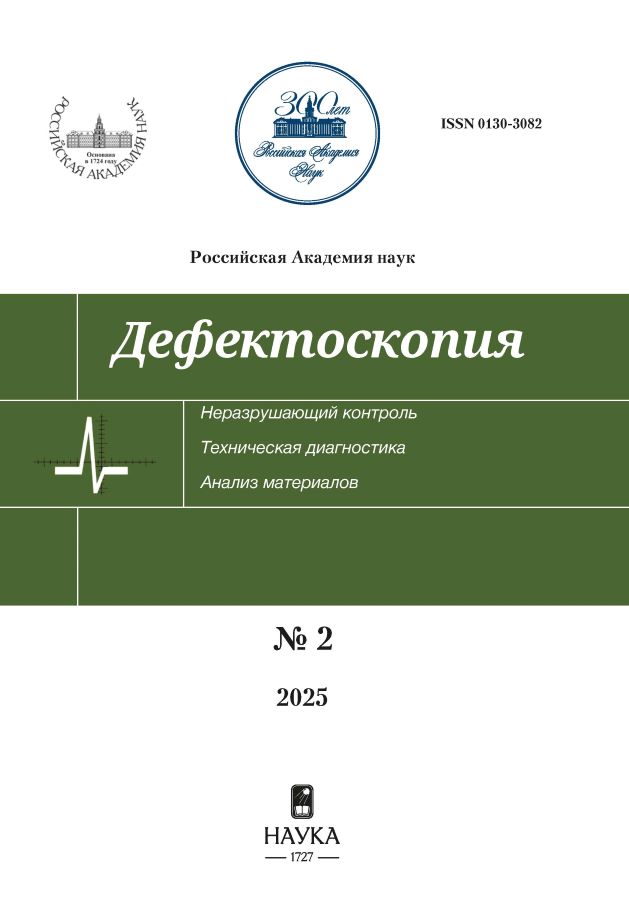Hysteresis Interference of Defect Fields
- 作者: Pavlyuchenko V.V.1, Darashevich E.S.1
-
隶属关系:
- Belarusian National Technical University
- 期: 编号 2 (2025)
- 页面: 28-38
- 栏目: Electromagnetic methods
- URL: https://ruspoj.com/0130-3082/article/view/685872
- DOI: https://doi.org/10.31857/S0130308225020035
- ID: 685872
如何引用文章
详细
The calculated initial and hysteresis branches of the electric voltage U (H) in a pulsed magnetic field of strength H are presented, corresponding to the branches of magnetization in the operating magnetic field and the residual magnetization of an object made of ferromagnetic material and similar branches of the used magnetic carrier (MC). The impact on an object with MN was carried out by magnetic field pulses to obtain stationary states of magnetization of an object with an internal defect, the field of which is modeled by the field of a linear inductor, the construction of spatial distributions of hysteretic interference (HI) and the creation of programs for calculating HI, which made it possible to increase the accuracy of monitoring the properties of objects.
全文:
作者简介
V. Pavlyuchenko
Belarusian National Technical University
Email: ess.doroshevich@gmail.com
白俄罗斯, 65, Nezavisimost Ave., 220013, Minsk
E. Darashevich
Belarusian National Technical University
编辑信件的主要联系方式.
Email: ess.doroshevich@gmail.com
白俄罗斯, 65, Nezavisimost Ave., 220013, Minsk
参考
- Pavlyuchenko V.V., Doroshevich E.S. Nondestructive control of objects made of electroconductive materials in pulsed magnetic fields // Russian Journal of Nondestructive Testing. 2010. V. 46. No. 1. P. 810—818.
- Pavlyuchenko V.V., Doroshevich E.S., Pivovarov V.L. Calculation of residual magnetic-field distributions upon hysteretic interference of a pulsed magnetic field // Russian Journal of Nondestructive Testing. 2015. V. 51. No. 1. P. 8—16.
- Pavlyuchenko V.V., Doroshevich E.S. Hysteretic Interference of Magnetic Field of a Moving Linear Inductor // Russian Journal of Nondestructive Testing. 2020. V. 56. No. 1. P. 49—57.
- Pavlyuchenko V.V., Doroshevich E.S. Imaging Electric Signals of a Magnetic Field Transducer with Hysteretic Interference for Testing Metals in Pulsed Magnetic Fields // Russian Journal of Nondestructive Testing. 2020. V. 56. No. 11. P. 907—914.
- Pavlyuchenko V.V., Doroshevich E.S. Hysteretic Interference of Time-Overlapping Magnetic Field Pulses // Russian Journal of Nondestructive Testing. 2019. V. 55. No. 12. P. 949—956.
- Pavlyuchenko V.V., Doroshevich E.S. Differential Background of Electric Signal Readfrom an Induction Magnetic Head // Russian Journal of Nondestructive Testing. 2021. V. 57. No. 8. P. 706—716.
- Falkevich A.S. Magnetographic inspection of welded joints. M.: Мashinostroenie, 1966. 176 p.
- Kozlov V.S. Magnetic flaw detection technique. Mn.: Vyshaychay shkola, 1976. 256 p.
- Mikhailov S.P., Shcherbinin V.E. Physical basis of magnetic flaw detection. M.: Nauka,1992. 238 p.
- Muzhitsky V.F. Model of a surface defect and calculation of the topography of its magnetostatic field // Defectoskopiya. 1987. No 3. P. 24—30.
- Shleenkov A.S. Determination of geometric parameters of defects from the reconstructed magnetic stray field // Defectoskopiya. 1991. No 10. P. 49—55.
- Shcherbinin V.E. Fields of defects on the inner and outer surfaces of pipes under circular magnetization // Defectoskopiya. 1972. No. 2. P. 11.
- Kharitonov Yu.N. Integration of pulses with distribution over their duration // Instruments and experimental technique. 1966. No 5. P. 227—228.
- Kharitonov Yu.N. Long-term Barkhausen jumps caused by mechanical stresses // Physics of metals and metallurgy. 1968. V. 25. No 5. P. 245—246.
- Rudyak V.M. Barkhausen effect in ferromagnets // Scientific Notes оf Kaliningrad State Pedagogical University. 1966. V. 40. P. 49.
- Ivlev V.F., Prokopenko V.S. Barkhausen effect in cylindrical iron films // News of Higher Education Institutions. 1962. No 1. P. 154—158
- Ivlev V.F., Ilyushenko V.L., Aseeva L.I. Study of irreversible jumps of magnetization reversal in ferromagnets // Bulletin of the Academy of Sciences. 1957. V. 21. No. 9. P. 75.
- Rudyak V.M. On the relationship between the Barkhausen effect and the magnitude of residual magnetization // Reports of the Academy of Sciences. 1965. V. 164. No. 4. P. 782.
- Vengrinovich V.L. Magnetic noise structuroscopy. Minsk: Science and Technology, 1991. 285 p.
- Astakhov V.I., Danilina E.M., Ershov Yu.K. On the issue of diagnostics of a plate with a crack using the eddy current method // Defectoskopiya. 2018. No. 3. P. 39—49.
- Pechenkov A.N., Shcherbinin V.E. Eddy currents and fields of conducting and magnetizable spherical inclusions in a non-magnetic medium // Defectoskopiya. 2016. No. 4. P. 48—55.
- Novoslugina A.P., Smorodinsky Ya.G. Calculation method for assessing the parameters of defects in steel // Defectoskopiya. 2017. No. 11. P. 13—19.
- Pavlyuchenko V.V., Doroshevich E.S. Testing for Defects in Pulsed Magnetic Field Transmitted Through Metal // Russian Journal of Nondestructive Testing. 2021. V. 57. No. 10. P. 856—864.
补充文件















